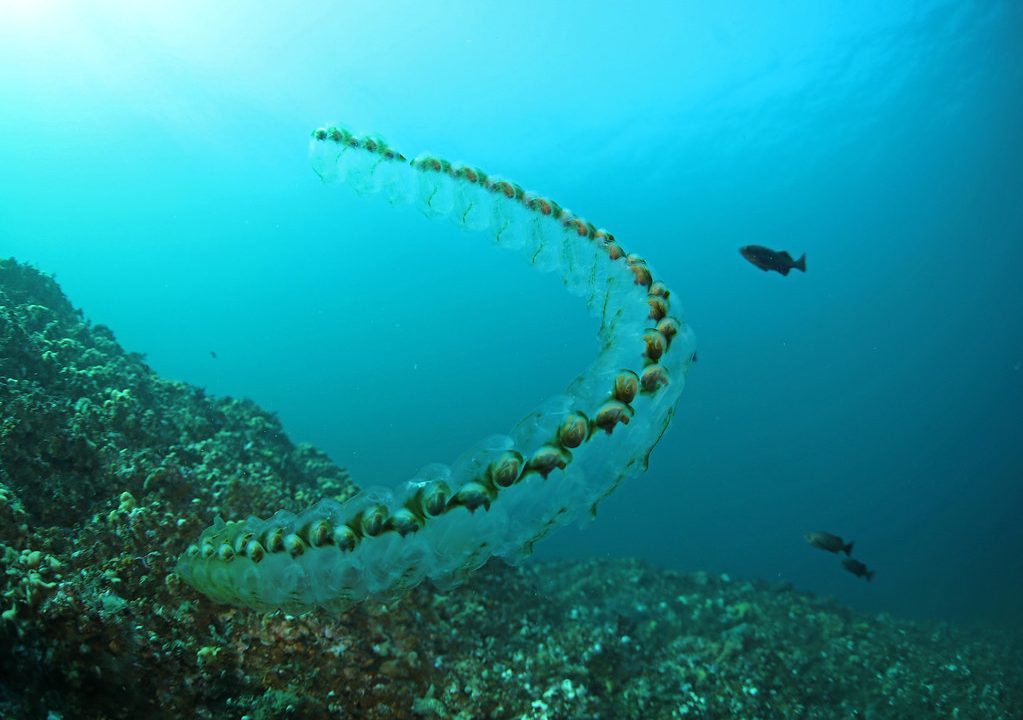Written by Line Willersrud and Rita M. Austin
The phylum Chordata contains the three subphylums, Tunicata, Cephalochordata and Vertebrata. Vertebrata, which includes humans and all other mammals, birds, fishes, amphibians and reptiles, are differentiated from other chordates by having an enclosed vertebral column, the backbone. But inclusion in phylum Chordata does not require a vertebral column, only a notochord, which encompasses all the invertebrate chordates, such as marine lancets and sea squirts. Classification as Chordata requires five key characteristics to occur at some life stage; namely, 1) a notochord, 2) dorsal tubular nerve cord, 3) pharyngeal pouches or slits (only in embryos of terrestrial vertebrates, and 5) a postanal tail. However, organisms in the Tunicata subphylum subvert several of these characteristics later in life. Incredibly, while tunicate larvae have all these characteristics, metamorphosis into the adult stage sees the notochord restricted to the tail, and ultimately disappearing later, and the dorsal nerve cord reduced to a single nerve ganglion. Reduction of these key chordate characteristics is one fascinating aspect of tunicates!

living larvae to a sessile adult. (https://www.mun.ca/biology/scarr/Ascidian_metamorphosis_2.gif)
Tunicates are marine invertebrate filter feeding animals. There are ~3000 known species worldwide, and ~95 known species in Norway. They can be divided into three classes: Ascidiacea, Thaliacea (salps) and Appendicularia (larvaceans). Ascidiacea are the most common, but all tunicates can be found in oceans worldwide, from shallow waters to great depths.
The name ‘Tunicata’ comes from the animal’s outer “cape”, the “tunic”, secreted from the epithelium containing a cellulose-like protein called tunicin. The tunic functions as a sort of exoskeleton, providing the animal with protection and support to the inner structures, and varies in thickness and consistency between the three classes, ranging in appearance from transparent and gelatinous to tough and leathery. While Tunicates are hermaphroditic with simple reproductive systems, they can also reproduce asexually by budding.
They feed by filtering water drawn through the incurrent siphon (oral siphon) and filtered through a ciliated pharynx containing a basketwork of pharyngeal slits, then, further into an atrium and out through an excurrent siphon (atrial siphon). A mucous net is secreted by the endostyle which then spreads across the inner face of the pharynx. Food particles brought in with the water are trapped by the mucous net before being brought to the esophagus. Nutrients are absorbed in the midgut while indigestible waste products are discharged through the anus and into the excurrent siphon.

Class Ascidiacea, the ascidians, include both solitary and colonial forms. They range between 10 mm to 60 cm in size, and some colonies can cover several meters. Nearly all ascidians are sessile, and they can attach to almost any surface.
Class Thaliacea, the salps, are pelagic (free-living) tunicates which float as single individuals or in cylindrical or chainlike colonies that can become tens of meters long. They are most abundant in tropical and subtropical waters.
Class Appendicularia, the larvaceans or appendicularians are also pelagic, like salps. They are solitary bioluminescent planktonic organisms. They are not more than about 5 mm long, and they resemble the larval stages of other tunicates, which is what gives them their name “larvaceans”. These tunicates build delicate houses, transparent spheres of mucus with filters and passages which water runs through. The inside of the house is lined with a feeding filter which traps tiny phytoplankton and bacteria which is then drawn into the animal’s mouth through a tube. When the filter gets clogged up with waste, the appendicularian abandons the house and builds a new one, which only takes a few minutes.


![]()
